There are quite a few ophthalmic pathologies in which you need to wear glasses. These include myopia, hyperopia, astigmatism. Moreover, almost always people after 40 or 50 years old have to use reading glasses, since they develop presbyopia (i.e. age hyperopia). There are other ophthalmologic diseases in which a similar correction is required. But first things first.
Note! "Before you start reading the article, find out how Albina Gurieva was able to defeat the vision problems by using ...
Let's take a closer look at each of the cases.
Doctors prescribe this method of vision correction for various refractive disorders (i.e., if the light rays are not properly refracted):
- - the image is focused behind the retina and it is difficult for a person to examine objects at close range. In this case, doctors prescribe.
- - The picture is focused in front of the retina, so the person begins to see worse into the distance. Ophthalmologists prescribe correction.
- - This is a visual defect that occurs due to the irregular shape of the cornea or lens. With this anomaly, the rays do not converge at one point on the retina, as is normal, but several foci form and as a result the picture is blurred and split apart. Corrected this violation with special or.
- - This is farsightedness associated with age-related changes in the human body.
In addition, the doctor often prescribes glasses for:
- Aniseikonia - the anomalous structure of the eyes, when the object is perceived by the right and left eyes in different sizes. This leads to the complexity of combining objects, perceived by the eyes, into one picture. The result of visual impairment is the appearance of headaches, drowsiness, fatigue, blurred vision.
- - this is a latent squint, in which the symmetrical position of the eyes changes. This violation is indicated by prism diopter.
If you suspect any of the above diseases, you should definitely consult a doctor. If you start these diseases, the vision may deteriorate even more, there will be a headache and severe eye fatigue due to the constant tension of the eye muscles.
Diagnostics
To reveal this or that violation the ophthalmologist conducts various examinations.
Visual acuity
At the beginning, the doctor checks the patient's visual acuity (not to be confused with refraction). Unlike the latter, it is the ability to recognize objects that are at a certain distance from each other. Check this figure with the help of various tables. In Russia and CIS countries, these are posters of Golovin, Sivtsev and Orlova (for children). In other countries, in particular the USA, this is the Snellen table.
Golovina  Sivtseva Orlova (children)
Sivtseva Orlova (children)
Norm is an indicator per unit (the subject sees 10 out of 12 lines on the table, for example, Sivtsev, he does not need to wear 100% of his eyesight and glasses). Sometimes this value is higher than normal and reach 2 or more units.
If the visual acuity of the subject is below the normal value, there is a possibility of the presence of refractive disorders (hyperopia, myopia or astigmatism) in him. Then the ophthalmologist conducts additional research (which we will discuss later) and reveals whether the patient has these diseases. When they are detected, the doctor usually writes a prescription for glasses or offers the patient other methods of correction.
Important! There is no direct relationship between visual acuity and clinical refraction. A low rate of the former may also indicate development in a patient, or for which wearing glasses is meaningless, and more often surgery is required.
Moreover, visual acuity depends on many factors:
- transparency of the cornea;
- clinical refraction;
- conditions of the lens and optic nerve;
- pupil width.
Clinical refraction
Refraction is the process of refraction of a beam of light in the optical medium of the eye. The curvature of the lens and the cornea affects this refractive power.
As we have said, very often a decrease in visual acuity is a consequence of refractive disorders. If the eye refraction is all right, then the decrease in the first indicator indicates the presence of some other anomalies (for example, low transparency of the cornea or lens, etc.).
When refractive disorders, the doctor prescribes glasses. Most often he spends refractometry.
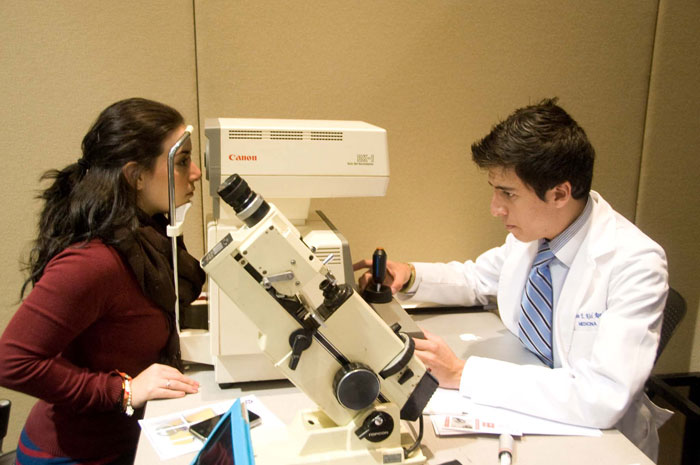
Objective: to determine the refractive power of the optical system of the eye.
How does it go:
- The patient sits down and the device fixes his head in the desired position (it must remain stationary).
- After that, the subject should look at various pictures that change sharpness.
- The doctor at this time directs the device at the pupil and measures the necessary indicators manually and automatically.
Often, to get the most accurate results before checking, the ophthalmologist will write out Atropin instillation.

Another way to test clinical refraction is optical lenses.
The ophthalmologist uses special minus or plus glasses (for myopia or hyperopia) and changes them until the optimal visual acuity of the subject is revealed. To understand whether a patient has astigmatism, the doctor uses cylindrical lenses.
Important! Low-grade astigmatism (up to 3 diopters) can be treated with glasses. But the average and high degree of this anomaly can be corrected only with the help of contact lenses or operations.
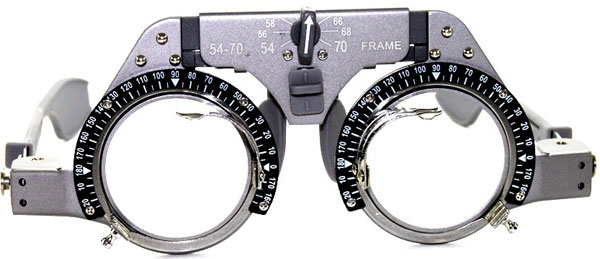
Optical lenses for eye examination
Cross Cover Maddox's Test and Study
These diagnostic methods are needed to reveal the heterophoria (latent strabismus) in a patient. If the doctor finds a slight deviation, then treatment is usually not required.
Ophthalmoeconometer
This device is needed to diagnose aniseikonia. The degree of violation is expressed as a percentage. Up to 2% it does not cause severe discomfort. When the degree is above 2.5%, treatment is required, which is aimed at correcting the size of the image on the retina (for this purpose, special glasses with aniseiconic lenses are used).
With a degree greater than 10%, the use of glasses is ineffective. And with a difference of more than 30% - correction with glasses does not help at all.
Diagnose and determine when to wear glasses, constantly or not, can only be a qualified specialist. If the picture is blurred in front of your eyes, your eyes often hurt and you must go to the doctor to see if you need treatment in your case. It is forbidden to choose glasses on your own, because if you pick them up the wrong vision can only worsen worse.
Myopia is an unpleasant, but rather common disease, in which an object is focused not on the retina, but directly in front of it. A person sees a blurred and blurred picture. If you look at nearby objects, this effect does not occur, however, when you try to look at objects that are far away, the person realizes that he cannot do this. The appearance and progression of this pathology is influenced by the change in the shape of the eyeball. In the normal state, it has a spherical shape, and when myopia becomes close to oval. If a person goes to the hospital with the above symptoms, he is diagnosed with myopia, scientifically sounding like myopia.
Basic information about myopia
| Stages of myopia | Description |
|---|---|
| Weak | Often this stage is not detected by the patient, as the vision deviates from the usual normal rate of only 1-3 diopters. |
| Average | More pronounced, can affect the decline in working capacity in some areas of professional activity. Visual impairment is manifested up to 6 diopters, while deviating from the norm by no less than 3 diopters |
| Strong | The error is manifested in terms of 6 diopters up to extremely difficult cases in which objects at a distance practically do not appear |
Myopia has the ability to progress. This is explained by the fact that pathologies in various structures do not lose their significance and are constantly aggravated. Sometimes the stretching of the eye reaches the maximum limit and the aggravation of the process proceeds so quickly that serious violations of the retina are observed up to its detachment, rupture or hemorrhage.
Usually this pathology occurs in people aged 7-12 years. The rapid aggravation of myopia is manifested before the age of 18, and then the process is chronic. In order to stabilize the vision, it is necessary to perform exercises and use special therapy, then a positive effect may occur, but it is extremely rare to achieve a complete cure by easy means.

Myopia is currently being treated by a variety of methods, the main of which is wearing glasses and lenses, since it is not a traumatic, inexpensive and convenient way to restore the ability to see all objects for a long time as it should be. Medicines are also often used, regular exercises are carried out, and in difficult cases it is possible to use surgical correction.
Features of visual processes in people suffering from myopia
Such people perfectly distinguish objects located close by. If they do not have accompanying pathologies, they can boast the clearest distinction of objects. As soon as patients with myopia direct their gaze to distant objects, the contours instantly become blurred, and the image changes along the lines, it becomes more generalized. Sometimes when myopia additionally develops astigmatism. In this case, the person loses the ability to clearly distinguish objects not only away, but also at close range.

Definition of myopia: minus or plus?
Myopia is always marked by a negative indicator.. All patients should understand that in order to correct any manifestations of this disease, it is necessary to choose devices for improving vision only with a minus sign. When a person wants to make his vision as clear as possible, he should consult a specialist in order to find the most suitable negative lenses. Wearing devices for vision in childhood makes it possible to improve and gradually restore it, and in the more adult period, as well as in the elderly state, people acquire these accessories for the temporary maintenance of eye condition, as well as auxiliary devices.
If a person develops hyperopia, he recognizes objects in the background well, but cannot perform hard work. When myopia appears, the effect becomes completely opposite. When myopia purchased devices to improve vision exclusively with a minus sign. If a person gets farsightedness, he has to use plus lenses, which differ in convex shape.

The patient can distinguish myopia from hyperopia. If there are suspicions about these diseases, it is necessary to approach an ophthalmologist for a consultation, if necessary, to undergo a full examination. It should be remembered that in some cases, myopia manifests itself together with long-sightedness, which requires more specialist attention and selection of enhanced correction methods.
The causes of myopia
Often a person has normal vision, and over time is forced to wear glasses or lenses with a minus sign. Myopia may develop due to a number of reasons:
| The reasons | Description |
|---|---|
| Strong eye loads | This applies to the wrong way of life of people, when they read, write, spend time at the computer or constantly watch TV because of the need or for a specific need. |
| Hereditary factor | Sometimes myopia is genetically caused and manifests at birth or develops as it grows up, which can be predicted by conducting a series of surveys. |
| Incorrect treatment of eye pathologies | In some cases, incompetent doctors pick up glasses or lenses to get rid of any eye diseases, including myopia, but at the same time provoke the aggravation or the appearance of myopia as an additional disease. |
| Violations in the vascular system | Myopia appears as a complication of another disease that affects the state of the blood supply to the eye system or the whole body. |
| Malnutrition | Eye tissue is constantly updated. If a person does not consume enough vitamins and other essential trace elements, he will have to wear glasses or lenses over time to be able to clearly distinguish surrounding objects. |
Myopia treatment
The disease in any cases amenable to correction. This applies even to those situations where a person almost completely loses the ability to distinguish nearby objects. The task of the patient is timely referral to a specialist and an obstacle to the development of related diseases.

The main ways of getting rid of myopia, which are effective for each patient:
- Use lenses and glasses. This allows not only to provide improved vision immediately after applying the method, but also to stop the progression of the pathology, to gradually influence the processes of self-repair of eye tissue.
- Refractive therapy, which consists in the constant use of night lenses.
- Correction of pathologies with the help of laser beams.
- Update the lens, that is, the complete removal of the old with the insertion of an artificial element.
- Putting special lenses inside the eye.
High degree of myopia
If the patient is told that his vision has fallen by more than 6 diopters, he is automatically assigned to a group of people suffering from a high degree of myopia. Sometimes this value increases to 15 diopters. With this course of the disease, it is difficult to correct vision with light measures, since they do not give sufficient results. Laser with strong deviations can not be used. Doctors for radical correction using implantation of hard lenses.

Fight myopia
Sometimes children suffer from myopia, while the deterioration of the eye occurs no more than 0.5 diopters each year. This situation can be corrected by conservative methods, which is absolutely painless for the child, such treatment with proper conduct causes only positive emotions. It is necessary to perform such procedures step by step:
- Step 1.Selection of lenses or glasses by consulting a specialist. If the patient needs rare types of devices for vision correction, an individual order will have to be made.
- Step 2.Exercises for the development and strengthening of the eye nerves and muscles.
- Step 3.Use special drops, and they should be applied in a timely manner.
- Step 4.Reception of complexes of vitamins, where the necessary substances are selected for enhancing the vision as a whole.
- Step 5.Reduction of loads on the eyes, timely use of breaks in work, study or intense games.
Methods for the elimination of myopia
| Method | Description |
|---|---|
| Infrared radiation | Certain fragments of the eyes are influenced by a significant dose of the required radiation, and the apparatus acts from the closest possible distance |
| Vacuum massage | This method is necessary to achieve a lasting positive effect, as it allows the maximum modernization of the hydrodynamics of the visual apparatus. |
| Laser therapy | This is a whole range of methods designed to help inborn or acquired pathology in various ways. Using this method, it is possible to modernize the spatial perception of objects, improve accommodation, the functioning of nerve cells located on the retina |
| Electrostimulation | The impact of a small dose of current on the visual apparatus. All the elements of this system are stimulated |
| Ambliokor | Auto-training is done on the video-computer method. |
| Ophthalmic surgery | It is used to treat myopia only in childhood. Indications for such an operation are excessive progression of the disease, which is more than 1 diopter per year. Commonly used scleroplasty technique |
Video - In this is about child or school myopia. Causes, treatment and prevention
Treatment of myopia in adolescent children
To achieve a lasting positive effect in the treatment of myopia in adolescents, it is necessary to act comprehensively, without neglecting any possibility of improving or stabilizing the situation. If the cure for the disease occurs successfully due to properly selected measures, noticeable positive changes can be waited after 4-6 months.
It is necessary to carry out such actions:
- Step 1.Contact an ophthalmologist with a long history of work and an excellent reputation. First, he tells the plan of action for the treatment of myopia, notes the real prospects, and then clarifies the necessary actions that often have to be done daily.
- Step 2. The passage of classes on specially designed devices. They are available in most centers for the restoration of vision, so it is not difficult to apply courses of such treatment at least 2 times a year.
- Step 3.Physiotherapy for the general restoration of a healthy state of the visual apparatus.
- Step 4. Therapy with drugs.
- Step 5.Scleroplasty. It is carried out to achieve not a direct, but an indirect result. Due to trophic features during such surgery, blood supply to the back of the eyeball is significantly improved.
If a person has myopia in a weak form, he may for a long time be limited to the use of special glasses or to acquire lenses. It should be remembered that these correction elements must necessarily be marked with a minus sign. Then there is a lasting positive effect, in which not only the immediate improvement of vision is possible when wearing accessories, but also its gradual recovery. If necessary, resort to medication, physiotherapy, exercise and surgery.
Myopia (myopia) is a serious problem that is associated not only with deterioration of vision, but also with an increased risk of developing complications. Near-sighted people find it difficult to perform many activities: driving a car, reading signs, information boards, and with a high degree of myopia it is not easy to even see a familiar face at a distance of one or two meters.
According to the World Health Organization, up to 30% of the world's population suffers from this problem. The number of patients suffering from this myopia is steadily increasing. Very often, the violation occurs in schoolchildren, students. People with good eyesight sometimes do not understand what is myopia: "plus" or "minus"? Let's look at this problem together.
Myopia is a visual impairment, in which a person sees poorly objects located far away, but sees objects very close. Myopia is also called myopia.
One of the main components of the eye is the cornea and lens. They are able to pass and refract the rays of light. An image appears on the retina of the eye, which is transmitted to the brain by means of nerve impulses along the optic nerve.
If the cornea and lens refract the rays so that the focus is on the retina, the image will be clear and the vision will be 100%.
When myopia image is blurry and fuzzy due to two anomalous factors:
- The eye is highly elongated, and the retina moves away from a stable focus. With myopia in humans, the eye reaches 30 millimeters. A normal healthy person has an eye size of 23-24 mm.
- The lens and cornea refract light rays too much.
People with myopia find it difficult to see objects that are far away from them. But objects close to the eyes of a myopic person sees well.

The reasons
Myopia most often develops during school years. Heredity plays a significant role in the development of pathology. It is important to consider whether one or both parents suffer from this disease. If there is a violation in both the father and the mother, then in 50% of cases it will occur in the child before he enters the age of majority. If the parents are healthy, the risk of developing the disease is significantly reduced and is 8%.
Among the main factors contributing to the development of myopia, one can distinguish long-term work at close range under poor hygienic conditions or inadequate lighting. This reason is especially relevant today due to the mass distribution of computers.
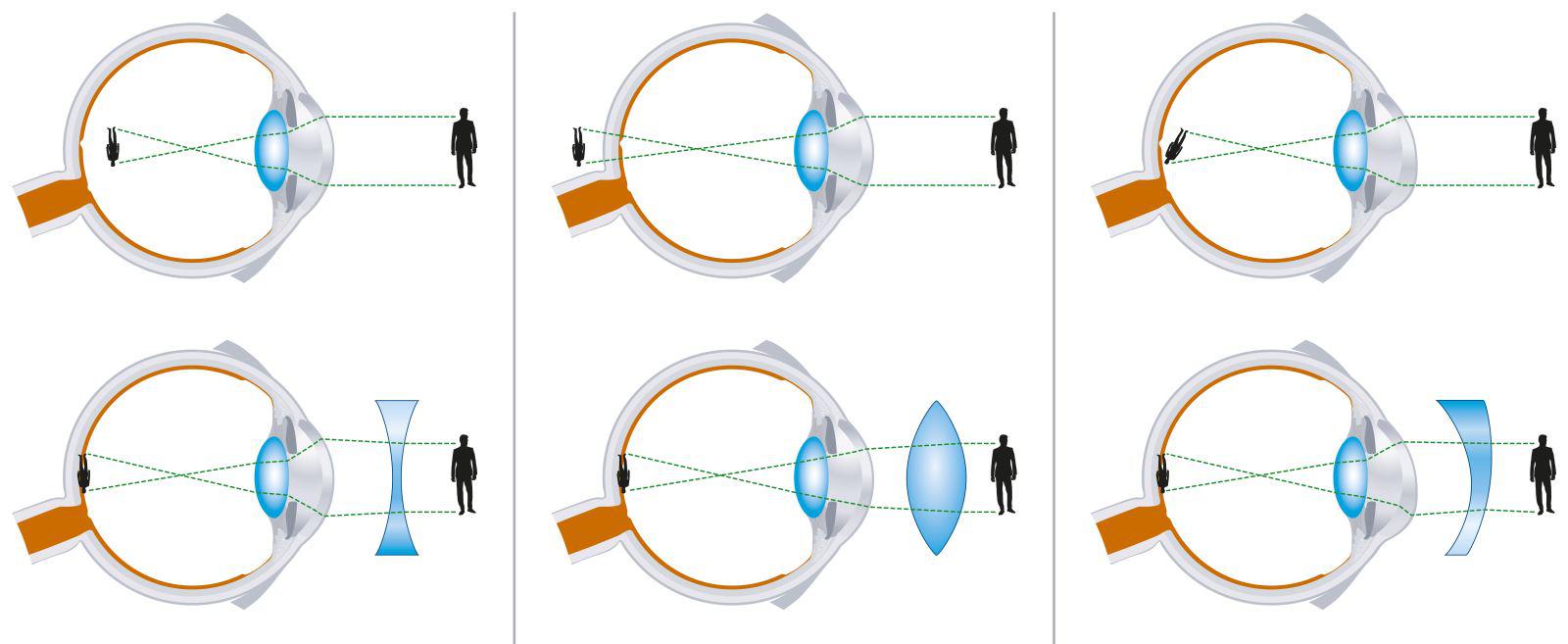 Distortion of the lens and reflection of objects
Distortion of the lens and reflection of objects The development of myopia also contributes to the weakening of the eye muscles. To solve this problem, special complexes of physical exercises have been developed, which can be used for both therapeutic and prophylactic purposes. Medical exercises for the eyes slow the progression of myopia. Previously, ophthalmologists often recommended that myopic patients limit their physical activity. However, today the opinion of oculists has changed: moderate loads with a rational mode of rest and sleep are recommended.
 At a young age, myopia can be caused by:
At a young age, myopia can be caused by:
- accommodation spasm;
- keratoconus (changing the shape of the cornea;
- displacement of the lens with injuries (dislocation, subluxation);
- lens sclerosis.
The latter pathology leads to the development of myopia in old age.
There are other reasons that lead to the development of myopia:
- Lack of nutrients in the body, vitamins, minerals. Vitamins of group B and C, as well as such microelements as magnesium, zinc, copper, manganese, affect to a greater extent. All of them are necessary for the proper development and formation of the sclera tissue of the eye.
- Any eye strain caused by prolonged and continuous visual work.
- The lack of correct correction when the first symptoms of myopia appear. If the first signs of the disease are ignored, then myopia will progress and lead to a significant deterioration in vision.
- Incorrectly chosen glasses or contact lenses for vision correction when myopia begins.
- Congenital pathology (for example, weakness of the eye muscles responsible for changing the curvature of the lens).
- Some illnesses of sight (strabismus, astigmatism, etc.).
- Increased intracranial and intraocular pressure.
- All conditions that cause a weakening of the body and disrupt the supply of nutrients to the eye (some infectious diseases, disruptions in the hormonal system, birth and head injuries).
Symptoms
The main symptoms of myopia are:
- Fuzzy vision of distant objects;
- "Flies" before the eyes;
- frequent headaches;
- eye fatigue;
- split objects;
- violation of twilight vision (in the dark, myopic people hardly control the machine and poorly oriented on the street);
- color determination errors.
Depending on the degree of myopia, the patient's vision can vary from a slight blurring to a full blur of the image, even a few meters away.
Patients with a high degree of myopia see literally right near the nose, but the further point of clear vision lies only a few centimeters from the eye.
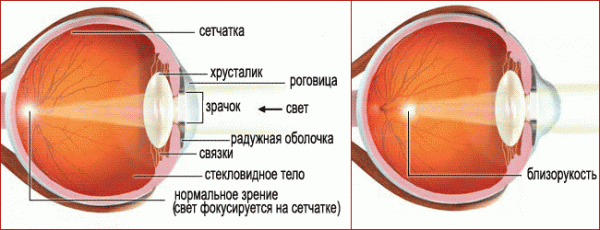
Myopia can be combined with other visual diseases, such as astigmatism. Signs of such a complicated form of the disease are:
- bifurcation of objects;
- distortion of objects;
- curved lines (instead of straight lines).
"Plus" or "minus"?
After the study of visual acuity, all patients with impaired refraction carry out a trial correction of vision with the help of lenses. Lenses are of two types: scattering, denoted in ophthalmology with a "-" (minus), and collecting - denoted by the sign "+" (plus).
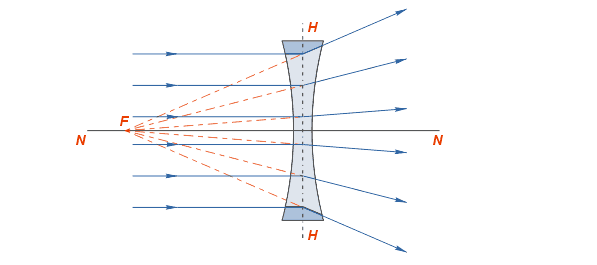 Focus lens
Focus lens For the correction of myopia apply scattering ("negative") lenses. In this way, when they talk about glasses or lenses for the correction of myopia, they always mean “minus”, not “plus”. But for the correction of farsightedness used "positive" or collecting lenses, therefore, farsightedness is a "plus". And what do the numbers mean, for example -2, -3.75, or any other?
The numbers indicate the optical power of the lenses needed by the patient with myopia to clearly see the 10th row in the Sivtsev table. The power of the lenses is expressed in diopters and may have a fractional value. When writing out a prescription for glasses or lenses for each eye, its own value of the lens strength is indicated.
There is such a thing as “false myopia”, which is not associated with eye changes and does not belong to either “minus” or “plus”. This condition is caused by constant eye strain when working with closely spaced objects. False myopia is treated with exercises, sometimes with medications, but does not require wearing glasses or lenses. In order not to confuse true myopia with false and not to gain glasses in vain, you should immediately consult a doctor at the first signs of deterioration of vision.
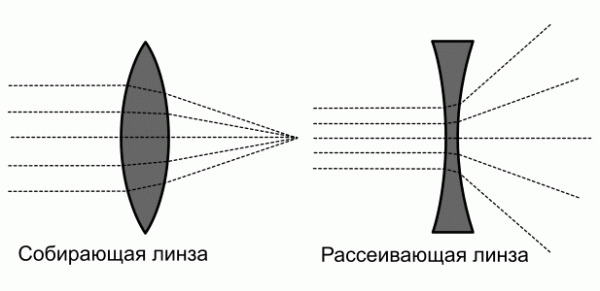 The difference between collecting and diffusing lenses
The difference between collecting and diffusing lenses Diagnostics
Only an optometrist can detect the disease, determine the degree of myopia and choose the most appropriate method of treatment for this case.
Diagnosis of myopia requires research such as:
- checking visual acuity into the distance without glasses;
- determination of the refraction (refraction) of the eyes and the degree of myopia;
- selection of the right lenses;
- measuring the length of the eye in the ultrasound room;
- measurement of the thickness of the cornea in its various points;
- examination of the fundus of the eye (will allow the doctor to assess the condition of the retina, blood vessels, optic nerve of each eye);
- selection of the right lenses;
- selection of the method of correction and treatment.
Lack of correction of myopia or incorrectly chosen glasses (lenses) can lead to a rapid deterioration of vision and the development of progressive myopia.
Treatment
Treatment of myopia is a complex process that can only be managed with the help of an ophthalmologist.
Modern methods of improving vision are diverse:
 Vision correction with glasses
Vision correction with glasses - Laser Correction.
- Optical correction of myopia.
- Methods of surgical intervention. Used with a high degree of disease development. It is possible to replace the lens with an intraocular lens, installing an actual lens.
- Drug treatment of the disease.
- Correction of nutrition to improve the blood supply to the eye and the supply of nutrients to it.
This is the most modern, safe and effective way to improve vision and get rid of the problem of myopia. Laser correction will allow the patient to refuse to wear glasses and contact lenses. The essence of the intervention is to change the shape of the cornea, due to which its optical power is reduced. With the help of a laser, it is possible to create the effect of wearing glasses, as if located inside the eyes, as a result of which, after refraction in the lens, light rays are focused on its retina.
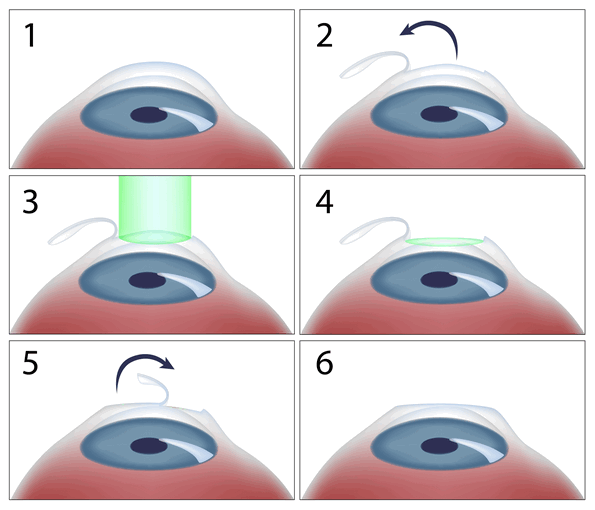
There are several methods of correction using a laser:
- LASIK (creating parameters of the cornea on the template);
- Super LASIK (creation of individual parameters of the cornea);
- PRK (used for thin cornea and low myopia).
Each method has its own characteristics and is applied depending on the state of the eyes and financial capabilities of a person.
Eyeglass correction
Glasses are traditionally used to correct the vision of a patient suffering from myopia. They are installed diffusing lenses that weaken the optical system of the eye and push the image on the retina. If myopia is complicated by astigmatism, then wearing glasses with cylinders is required.
Contact correction
 Today, contact correction is gaining increasing popularity among young people. Contact lenses have several advantages over glasses. With proper selection and use, they provide sharper vision than glasses. Good lenses allow you to fully restore visual acuity without distortion and aberration, which can not provide the best glasses.
Today, contact correction is gaining increasing popularity among young people. Contact lenses have several advantages over glasses. With proper selection and use, they provide sharper vision than glasses. Good lenses allow you to fully restore visual acuity without distortion and aberration, which can not provide the best glasses.
Complications
In case of late treatment or illiterate correction of myopia, its progression is possible. Complications such as:
- staphyla sclera formation (bulging);
- retinal dystrophy;
- hemorrhages on the retina and in the vitreous;
- cataract;
- retinal disinsertion.
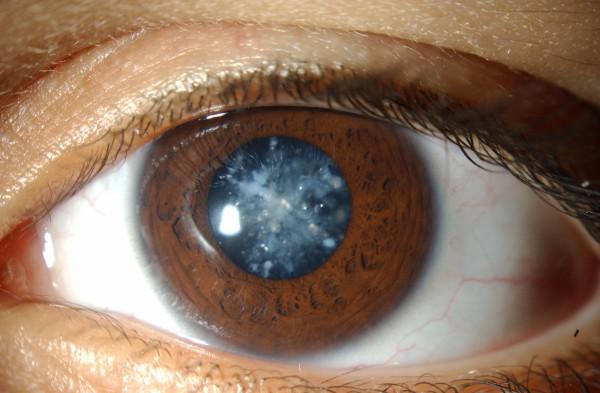 Cataract as a result of neglected myopia
Cataract as a result of neglected myopia Complications of myopia can occur at any age. In addition, the destructive processes on the retina sometimes develop after the surgical treatment of myopia due to the modified shape of the eye, which is not corrected.
In case of myopia (especially high degree), it is necessary to regularly undergo examinations by an ophthalmologist, which will allow to monitor the state of the retina and provide an opportunity to detect ruptures, holes, thinning in time.
Prevention
Any disease is easier to prevent than to cure. Preventing myopia involves the following measures:
- Regulation of the lighting mode. Visual loads are allowed only in good light using the overhead light, desk lamp 60-100 watts. Do not work with fluorescent lights.
- Compliance with the regime of visual and physical stress. It is recommended to alternate visual stress with active, mobile rest: with myopia up to 3 diopters, physical loads are not limited, more than 3 diopters - weight lifting, jumping and some types of competitions are prohibited.
- Gymnastics for the eyes (every 20-30 minutes).
- Correct vision correctionappointed by the ophthalmologist.
- Muscle training, the voltage of which leads to the growth of myopia (laser stimulation, video-computer vision correction, eye drops, special courses of eye gymnastics).
- Ophthalmologic diagnostics: ultrasound measurement of the longitudinal size of the eye (1 time in six months).
- Restorative activities (swimming, massage of the neck area, douche) on the recommendation of an ophthalmologist.
- Full balanced nutrition.
Video
findings
So, myopia () is a disease that needs to be treated in time to prevent progression and many complications. With myopia, negative lenses are prescribed by a doctor. Violation can lead to a complete loss of vision, therefore, its prevention and correct correction are extremely important.
- In contact with 0
- Google+ 0
- OK 0
- Facebook 0








